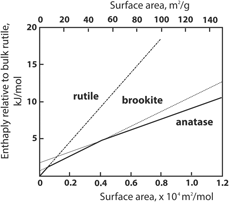Crossref Citations
This article has been cited by the following publications. This list is generated based on data provided by
Crossref.
Niedermaier, Matthias
Schwab, Thomas
Kube, Pierre
Zickler, Gregor A.
Trunschke, Annette
and
Diwald, Oliver
2020.
Catalytic activity, water formation, and sintering: Methane activation over Co- and Fe-doped MgO nanocrystals.
The Journal of Chemical Physics,
Vol. 152,
Issue. 7,
Kozerozhets, I.V.
Panasyuk, G.P.
Semenov, E.A.
Avdeeva, V.V.
Ivakin, Yu.D.
and
Danchevskaya, M.N.
2020.
New approach to prepare the highly pure ceramic precursor for the sapphire synthesis.
Ceramics International,
Vol. 46,
Issue. 18,
p.
28961.
Ahmad, Faozan
Agusta, Mohammad Kemal
Maezono, Ryo
and
Dipojono, Hermawan Kresno
2020.
DFT + U study of H2O adsorption and dissociation on stoichiometric and nonstoichiometric CuO(1 1 1) surfaces.
Journal of Physics: Condensed Matter,
Vol. 32,
Issue. 4,
p.
045001.
Liu, Tingting
Gautam, Siddharth S.
Daemen, Luke L.
Kolesnikov, Alexander I.
Anovitz, Lawrence M.
Hartl, Monika
and
Cole, David R.
2020.
Vibrational Behavior of Water Adsorbed on Forsterite (Mg2SiO4) Surfaces.
ACS Earth and Space Chemistry,
Vol. 4,
Issue. 7,
p.
1050.
Diwald, Oliver
and
Hartmann, Martin
2021.
Metal Oxide Nanoparticles.
p.
593.
Endres, Stefan Christian
Ciacchi, Lucio Colombi
and
Mädler, Lutz
2021.
A review of contact force models between nanoparticles in agglomerates, aggregates, and films.
Journal of Aerosol Science,
Vol. 153,
Issue. ,
p.
105719.
Thomele, Daniel
Baumann, Stefan O.
Schneider, Johannes
Sternig, Andreas K.
Shulda, Sarah
Richards, Ryan M.
Schwab, Thomas
Zickler, Gregor A.
Bourret, Gilles R.
and
Diwald, Oliver
2021.
Cubes to Cubes: Organization of MgO Particles into One-Dimensional and Two-Dimensional Nanostructures.
Crystal Growth & Design,
Vol. 21,
Issue. 8,
p.
4674.
Kozerozhets, I. V.
Panasyuk, G. P.
Semenov, E. A.
Vasil’ev, M. G.
Nikiforova, G. E.
and
Voroshilov, I. L.
2021.
Effect of Alkaline Medium on Hydrothermal Synthesis of Boehmite.
Russian Journal of Inorganic Chemistry,
Vol. 66,
Issue. 3,
p.
427.
Diwald, Oliver
2021.
Metal Oxide Nanoparticles.
p.
1.
Dickson, Matthew S.
Rosen, Peter F.
Neilsen, Grace
Calvin, Jason J.
Navrotsky, Alexandra
and
Woodfield, Brian F.
2021.
Heat capacity and thermodynamic functions of partially dehydrated sodium and zinc zeolite A (LTA).
American Mineralogist,
Vol. 106,
Issue. 8,
p.
1341.
Yu, Haixia
Guo, Chuanyu
Zhang, Xianfa
Cheng, Xiaoli
Xu, Yingming
Gao, Shan
and
Huo, Lihua
2022.
Tailoring Oxygen Vacancy of Co3O4 Microcubes by Annealing Co3[Co(CN)6]2 Template in Air for Ultrasensitive Humidity Mapping.
Small Structures,
Vol. 3,
Issue. 2,
Takeuchi, Masato
Kurosawa, Ryo
and
Ryu, Junichi
2022.
Vibrational spectroscopic evaluation of hydrophilic or hydrophobic properties of oxide surfaces.
Journal of Raman Spectroscopy,
Vol. 53,
Issue. 10,
p.
1793.
Jeong, Heonjae
Ertekin, Elif
and
Seebauer, Edmund G.
2022.
Surface-Based Post-synthesis Manipulation of Point Defects in Metal Oxides Using Liquid Water.
ACS Applied Materials & Interfaces,
Vol. 14,
Issue. 29,
p.
34059.
Rey, Jérôme
Clabaut, Paul
Réocreux, Romain
Steinmann, Stephan N.
and
Michel, Carine
2022.
Mechanistic Investigation and Free Energies of the Reactive Adsorption of Ethanol at the Alumina/Water Interface.
The Journal of Physical Chemistry C,
Vol. 126,
Issue. 17,
p.
7446.
Wang, Yaowen
Feng, Tao
Li, Xinbo
and
Li, Liping
2022.
Thermochemistry of nano-phased titanium dioxides relevant to energy application: A Review.
Chemical Thermodynamics and Thermal Analysis,
Vol. 5,
Issue. ,
p.
100033.
Steinmann, Stephan N.
and
Michel, Carine
2022.
How to Gain Atomistic Insights on Reactions at the Water/Solid Interface?.
ACS Catalysis,
Vol. 12,
Issue. 11,
p.
6294.
Lbadaoui-Darvas, Mária
Garberoglio, Giovanni
Karadima, Katerina S.
Cordeiro, M. Natália D. S.
Nenes, Athanasios
and
Takahama, Satoshi
2023.
Molecular simulations of interfacial systems: challenges, applications and future perspectives.
Molecular Simulation,
Vol. 49,
Issue. 12,
p.
1229.
Dippong, Thomas
Levei, Erika Andrea
Petean, Ioan
Deac, Iosif Grigore
and
Cadar, Oana
2023.
A Strategy for Tuning the Structure, Morphology, and Magnetic Properties of MnFe2O4/SiO2 Ceramic Nanocomposites via Mono-, Di-, and Trivalent Metal Ion Doping and Annealing.
Nanomaterials,
Vol. 13,
Issue. 14,
p.
2129.
Gotovac Atlagić, Suzana
Sukur, Sunčica
and
Babajić, Elvir
2023.
Encyclopedia of Green Materials.
p.
1.
Kozerozhets, Irina V.
Panasyuk, Georgii P.
Semenov, Evgenii A.
Avdeeva, Varvara V.
Danchevskaya, Marina N.
Simonenko, Nikolai P.
Vasiliev, Mikhail G.
Kozlova, Lyubov’ O.
and
Ivakin, Yuri D.
2023.
Recrystallization of nanosized boehmite in an aqueous medium.
Powder Technology,
Vol. 413,
Issue. ,
p.
118030.





